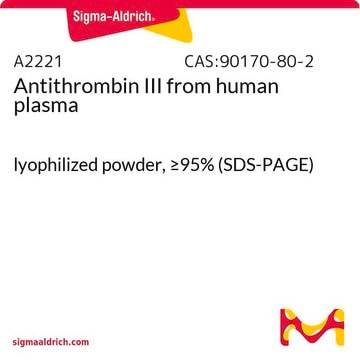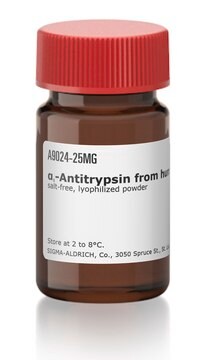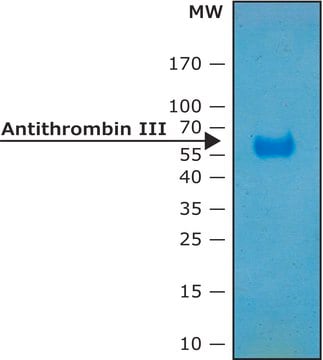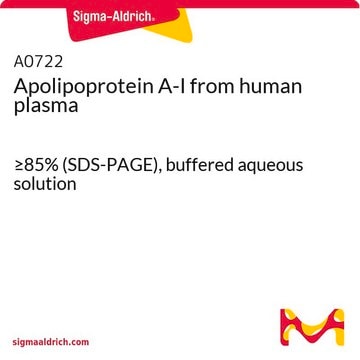SRP6316
Antithrombin III from human plasma
≥95% (SDS-PAGE)
Sinónimos:
SERPINC1
Iniciar sesiónpara Ver la Fijación de precios por contrato y de la organización
About This Item
UNSPSC Code:
12352202
NACRES:
NA.32
Productos recomendados
biological source
human
assay
≥95% (SDS-PAGE)
form
lyophilized
mol wt
58 kDa
packaging
pkg of 100 μg
pkg of 500 μg
UniProt accession no.
shipped in
wet ice
storage temp.
−20°C
Gene Information
human ... SERPINC1(462)
General description
SerpinC1, also known as antithrombin III (AT III), is a member of the serpin superfamily of serine protease inhibitors. The gene is mapped to human chromosome 1. SerpinC1 is a glycoprotein with three β-sheets and nine α-helices. The protein has an active site region and a heparin binding site.
Biochem/physiol Actions
SerpinC1, also known as antithrombin III (AT III), has been found to be a marker for disseminated intravascular coagulation (DIC) and to be of prognostic significance in septic patients. Antithrombin III synthesized in the liver is the principal plasma serpin of blood coagulation proteases and inhibits thrombin and other factors such as Xa by the formation of covalently linked complexes. Thus, it is one of the most important coagulation inhibitors and the fundamental enzyme for the therapeutical action of heparin. The inhibitory activity of AT III undergoes a dramatic increase in the presence of heparin and other glycosaminoglycans. Antithrombin III mediates the promotion of prostaglandin release, an inhibitor of leucocyte activation and downregulation of many proinflammatory cytokines. It exerts anti-inflammatory properties in addition to its anti-coagulative mechanisms. The deficiency or functional abnormality of AT III may result in an increased risk of thromboembolic disease, such as deep vein thrombosis and pulmonary embolism. In addition, it has been reported that AT III can alter or influence inflammatory processes via inhibition of NF (nuclear factor)-κB activation or actin polymerization. It is found in normal serum at 15mg/100mL. Found at higher levels in plasma than in serum because of complexing with thrombin during coagulation. Clinically, reduced levels are indicative of hypercoagulability. Reduction in the levels of antithrombin III enhances the severity of renal ischemia/reperfusion injury.
Physical form
Lyophilized from 50 mM Tris-HCl, pH 8.0, with 150 mM NaCl.
Reconstitution
In water or aqueous buffer
Storage Class
13 - Non Combustible Solids
wgk_germany
nwg
Certificados de análisis (COA)
Busque Certificados de análisis (COA) introduciendo el número de lote del producto. Los números de lote se encuentran en la etiqueta del producto después de las palabras «Lot» o «Batch»
¿Ya tiene este producto?
Encuentre la documentación para los productos que ha comprado recientemente en la Biblioteca de documentos.
Los clientes también vieron
Antithrombin III inhibits nuclear factor kappaB activation in human monocytes and vascular endothelial cells.
Oelschlager C, et al.
Blood, 99, 4015-4020 (2002)
Laboratory tests for antithrombin deficiency.
Khor B and Van Cott EM
American Journal of Hematology, 85, 947-950 (2010)
The anti-inflammatory properties of antithrombin III: new therapeutic implications.
Okajima K and Uchiba M
Seminars in Thrombosis and Hemostasis, 24, 27-32 (1998)
Plasma antithrombin III and thrombin generation time: correlation with hemoglobin A1 and fasting serum glucose in young diabetic women.
Sowers JR, et al.
Diabetes Care, 3, 655-658 (1980)
Antithrombin III supplementation in severe sepsis: beneficial effects on organ dysfunction.
Inthorn D, et al.
Shock, 8, 328-334 (1997)
Nuestro equipo de científicos tiene experiencia en todas las áreas de investigación: Ciencias de la vida, Ciencia de los materiales, Síntesis química, Cromatografía, Analítica y muchas otras.
Póngase en contacto con el Servicio técnico










